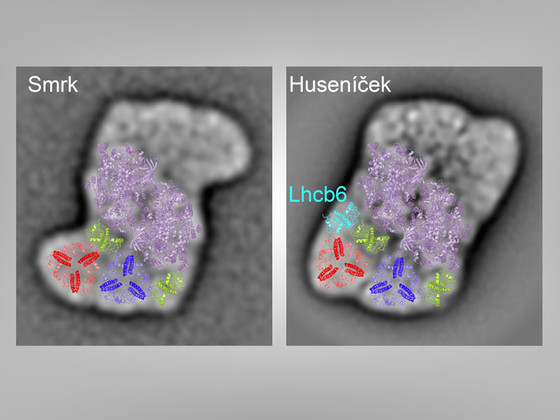Scientists from the Centre of the Region Haná for Biotechnological and Agricultural Research (CRH) in Olomouc achieved an unexpected discovery which upsets the current dogma concerning photosynthesis in the spruce and related species, and sheds light upon their evolution. During their investigation of another research project, they found out that the photosynthetic system (photosystem) of the spruce significantly differs from photosystems in other land plants. It lacks two key light-harvesting proteins that are also absent in less-developed organisms, such as green algae. The surprising finding was published in the renowned scientific journal New Phytologist.
“The difference of the photosystem in the spruce lies in the absence of light-harvesting proteins Lhcb3 and Lhcb6. Together with other proteins, they create light-harvesting antennae, by means of which light is absorbed, which is subsequently used by the plant in photochemical reactions. Until now it has been assumed that these proteins are shared by all land plants. They have been usually considered as a sort of marker, one of the essential characteristic features in land plants. They developed during the transition of photosynthetic organisms from water to land. According to the current understanding, they have played a key role in the adaptation of plants to the terrestrial environment, which is less stabile as compared to aquatic environments,” said Roman Kouřil, the main author of the study, explaining the revolutionary dimension of their finding.
The ensuing questions are why did the spruce “give up” both genes during its evolution and why its photosystem resembles its counterpart in the alga Chlamydomonas reinhardtii, an evolutionarily older organism. The genetic analysis made by Olomouc experts further showed that the aforementioned proteins were also lost in the gymnosperm genera Picea and Pinus (family Pinaceae) and Gnetum (Gnetales).
“During the evolution of land plants in the era roughly 250 million years ago, the largest disaster ever – the ‘Great Dying’ – occurred on the Earth, in the aftermath of which more than 70 percent of all terrestrial organisms went extinct and the conditions for life on the planet radically changed. The subsequent climatic changes led to the development of new plant species, including the Pinaceae and Gnetales family. These new plants ‘lost’ the proteins Lhcb3 and Lhcb6, and their light-harvesting system thus returned to the level of green algae,” said another author, Petr Ilík, Head of the Department of Biophysics in CRH.
According to him, it can only be speculated which environmental factor contributed to the evolution of these plants. One hypothesis says that the plants had to face an extreme intensity of light. “It was found out that under certain conditions, these proteins are not sufficiently produced even in green flowering plants – that is, when they are exposed to higher light intensity for a longer period,” explained Ilík.
The revolutionary finding was made during their study of another characteristic of the spruce, which is non-photochemical quenching. It is an ability in the plant to get rid of excessive absorbed light, which cannot be used in photochemical reactions and may be harmful. Tentative results suggest that this mechanism works differently in the spruce than in other species. Scientists are going to investigate now whether these two unique characteristics of the spruce are somehow related.
“More studies will follow; we will explore the newly established themes. Among other things, we would like to clarify the physiological impact of the Lhcb3 and Lhcb6 proteins’ absence – in other words, what the benefit of their loss could be. There is one rule in evolution: only that which is beneficial, will prove successful,” added Kouřil.
The Centre of the Region Haná for Biotechnological and Agricultural Research (CRH) is a joint facility of the Faculty of Science at Palacký University Olomouc, the Institute of Experimental Botany at the Academy of Sciences of the Czech Republic, and the Crop Research Institute in Prague.
